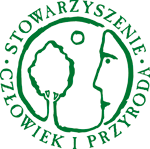A. Preparatory activities
A1 Preparation of technical documentation and maps for design purposes, obtaining a permit for construction of culverts for amphibians
A.1 activity is to prepare a full documentation necessary to start construction of culverts system for amphibians. The culverts construction requires a building permit. All technical projects have to be performed in accordance with the applicable requirements. Prior to the above steps, the appropriate maps for design purposes have to be prepared and the field location of the project’s objects has to be determined (geodetic services). The choice of the technical projects’ contractor will be carried out in accordance with the applicable regulations. The activity will be carried out between 4Q 2013 and the end of 2Q 2014.
C. Practical activities
C1 Construction of culverts systems for amphibians
DThis activity, preceded by the action A.1, will be about building culverts systems for amphibians in 6 locations. These places were selected on the basis of studies regarding amphibians migration and mortality, including the presence of European fire-bellied toad (Bombina bombina – code 1188) and Northern crested newt (Triturus cristatus - code 1166).
The first system of culverts, consisting of 13 tunnels and guiding barriers of total length of 1680 m, is located in the "Narew Marshes", near the village of Baciuty. Amphibians activity on this fragment of the road has been studied from 2002 to the present by the Scientific Association of Biologists from Bialystok. Over the years, a total of 35,897 individuals were found crossing the road in the spring. The amphibians observed were of 10 species: Common frog (Rana temporaria), Moor frog (Rana arvalis), Common toad (Bufo bufo), European common spadefoot (Pelobates fuscus), Smooth newt (Lissotriton vulgaris), European green toad (Pseudepidalea viridis), Common water frogs (Rana esculenta complex), European fire-bellied toad (Bombina bombina), European tree frog (Hyla arborea) and Northern crested newt (Triturus cristatus). The number of amphibians crossing the road ranged from 771 individuals in 2010 to 8858 individuals in 2006. In 2012, 1,122 individuals were found, belonging to five species of amphibians.
Two culverts systems (second and third) are located in the "Ostoja Suwalska". One system is going to be built in the Kleszczowek village (this will complement the existing system, which so far consists of two tunnels). 6 tunnels are going to be built from one side and one on the other side of the existing tunnel system. Such solution is necessary, because it turned out that the culverts system built in 2005 do not cover the whole area of intense amphibians migration and many individuals still continue to die on the road in there. Another system will be built on the provincial road no. 655 Suwalki - Rutka Tartak in Sidorowka village. The study of amphibians in this section of the road has been carried out since 2000 - every year more than eight out of twelve amphibian species occurring in the "Ostoja Suwalska" is crossing the road. The majority of these are: frogs (Common, Moor and Pool), next are European common spadefoot, common toad, European fire-bellied toad, Smooth newt and Northern crested newt. This short stretch of the road, within few days when the study is on, is being crossed by up to 4813 individuals (2008).
The fourth culverts system is located on the district road no. 1898N Budwiecie - Boczki, in the Boczki village. This road crosses a large population of amphibians, consisting of representatives of 8 species: Pool frog, Common frog, Moor frog, Common toad, European common spadefoot, European fire-bellied toad, Smooth newt and northern crested newt. The previous studies have shown that especially the fire-bellied toad can be found here in large number, a species of Annex II and IV of the Habitats Directive, protected under the Berne Convention and placed on the IUCN Red List. Amphibians mortality studies on this selected section of the road showed that during the spring migration, in some years, the mortality rate for the fire-bellied toad is up to 22 individuals/100 m/h. Apart from frogs, and Common frog in particular, a significant share of dead individuals are also Common toad and European common spadefoot.
Two culverts systems (fifth and sixth) are located by the eastern border of the Romincka Forest and protect amphibians crossing the district road no. 1953N Skajzgiry - Żytkiejmy in Skajzgiry I and Skajzgiry II villages. The systems for amphibians in Skajzgiry are located outside the Natura 2000 "Romincka Forest" area, but are essential for amphibians populations in eastern part of the area. During their seasonal migrations amphibians move from areas located on the east of the Ostoja’s border, towards the west, crossing the road Skajzgiry - Żytkiejmy, and enter the “Ostoja Suwalska" area (spring time). Throughout the season, amphibians move around the area, and during the autumn migration they move from the Ostja’s area to the east (outside’s the Ostoja’s area), where there are good places for wintering. The road Skajzgiry - Żytkiejmy is an artificial barrier for amphibians, which for many individuals is insurmountable, significantly affecting the state of amphibians population. Amphibians mortality study carried out on this road, showed a high mortality of frogs and Common toads. Especially high, almost every year, was Common toad mortality, not only during the spring migration, but also in the autumn - it ranged from 6 to 18 individuals per hour at 100 m stretch of road. On this road 2 fragments were clearly marked by amphibians mortality was particularly high – they were marked as Skajzgiry I and Skajzgiry II. Amphibian mortality on both of these road fragments were similar and reached up to 60 individuals/100 m/h. The most recent study of amphibians mortality on the road Skajzgiry - Żytkiejmy were conducted in the spring of 2014, before the start of culverts’ construction. The studies have shown that in the Skaistgirys I section the mortality rate was 68/100 m/h, and the Skaizgiry II section - 45/100 m/h.
This action is necessary to reduce the mortality of amphibians during their seasonal migrations. This will significantly strengthen amphibian populations in Natura 2000 areas of north-eastern Poland, including Northern crested newt (Triturus cristatus - code 1166) and European fire-bellied toad (Bombina bombina - code 1188), which are included in Annex II and IV of the Habitats Directive. Additionally, the culverts will help to reduce mortality of many other small vertebrates and reduce the negative barrier impact, which is caused by the communication route, on populations of small vertebrates such as hedgehogs, lizards, snake, shrews, etc.

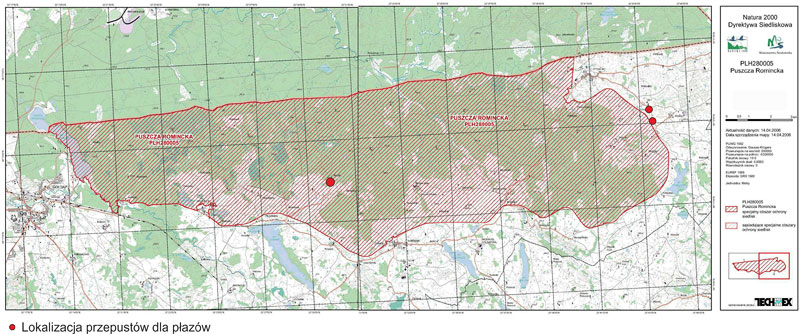
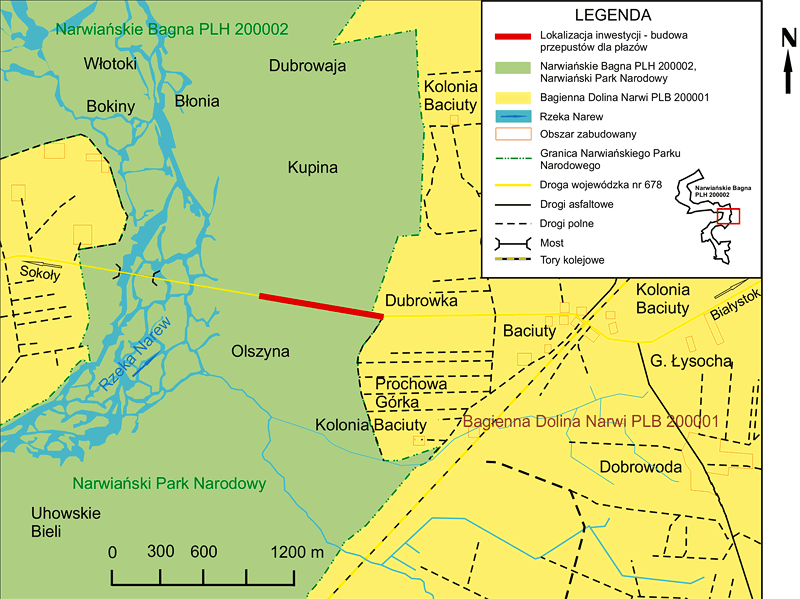

C2 Amphibians breeding places restoration
The following action will be to restore the vanishing water reservoirs, which are the breeding places of amphibians, including European fire-bellied toad (Bombina bombina - code 1188) and Northern crested newt (Triturus cristatus - code 1166), listed in Annex II and Annex IV of the Habitats Directive. Such tanks are heavily overgrown due succession, accelerated as a result of anthropogenic factors. These are mostly mid-field ponds, located in delves with no outflows. The selected reservoirs are going to have the excess of herbaceous and shrubby vegetation, as well as sediments, removed. Thus, the tanks will be deepened, their edges and bottom respectively shaped so as to constitute optimal living conditions for selected species of amphibians. The works on restoring the tanks will be carried out using heavy equipment in the winter at the turn of the years 2013/2014 and 2014/2015. The work will cover two Natura 2000 areas - "Ostoja Wigierska" - 10 water reservoirs with an area of 350 m2 each, and "Romincka Forest" - one reservoir with an area of 1500 m2.
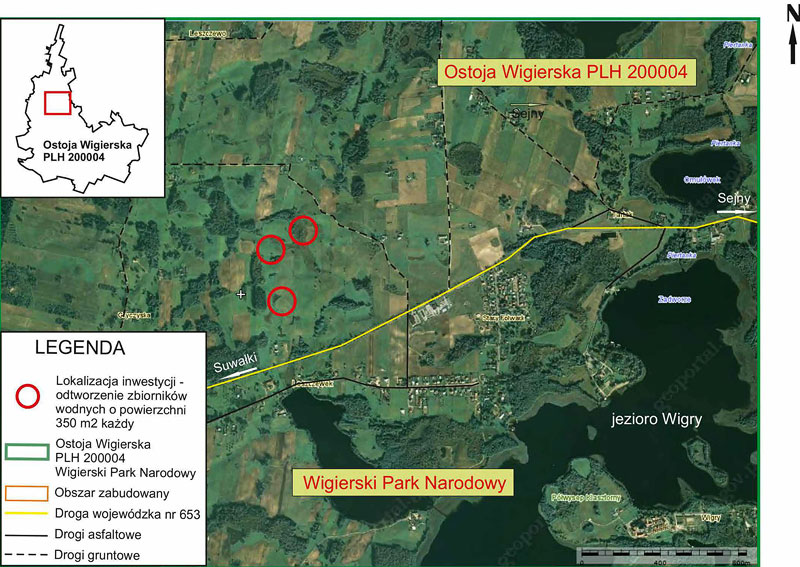

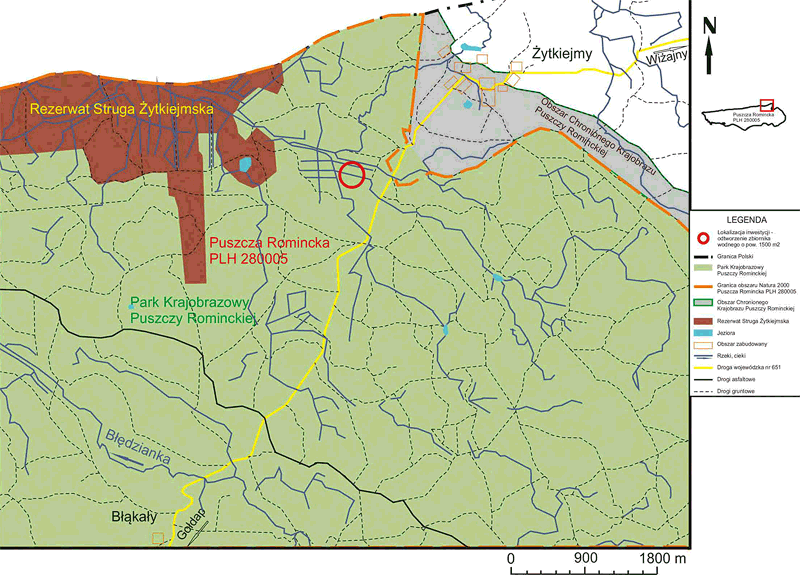
C3 Designing technical solutions to protect amphibians against the so-called anthropogenic traps
This action will be about developing technical solutions protecting amphibians (and other small vertebrate animals) from falling into the traps, which are both temporary (during construction) and permanent (target solutions) elements of the technical infrastructure. From the catalog of equipment used in construction, mainly regarding roads (e.g. the elements of drainage systems) those devices are going to be selected, that pose the greatest potential threat (traps) for small vertebrates. A group of experts, consisting of a designer, a road constructor and a biologist, will develop technical solutions to specific devices, protecting the animals from falling into these "traps". Prototypes of security facilities will be developed, which will then be tested in practice. The technical solutions are going to be corrected and published together with the description of the performance, based on the results of the field tests. The C.3 action performance results will be presented on the Internet on the project’s web site. The activities will be carried out in the period from 2Q 2014 till the end of Q2 2016.
C4 Organizing amphibians threats near communication routes monitoring
No public information about the location of amphibians migration routes crossing communication routes causes that even the investment activities conducive to wildlife conservation do not include in their plans the construction of facilities for animals protection. In order to get a build permit to build equipment to protect nature, often very expensive one, one needs reliable and detailed data on the nature conditions. Specialist environmental monitoring usually concerns only small areas and do not provide sufficient information to make such decisions.
One solution could be the common (social) monitoring, based on a network of institutions, organizations and even individuals who in a consistent and simple way record certain phenomena in nature. Schools (schools of vary degrees)and educational centers (e.g. ones operating in national or landscape parks) seem to be an eexcellent participants of such monitoring. Amphibians monitoring network, well-organized and based on simple methods, or actually monitoring of places where amphibians are most at risk from the use of motor vehicles, may include a large area and be a regular part of the education process for both the schools and extracurricular organizations. Within the C.4. activity it is expected to nominate 20 schools and educational centers that will participate in the monitoring. For those entities as a resource pack to help in the monitoring will be developed, which will contain detailed instructions on the observation of nature. The monitoring data will supply a specially designed computer database, which will be support by the "Man and Nature" Association. These data will be also possible to be used by schools and educational centers, using them in their educational activities. The amphibians threats by the roads monitoring network is going to be opened, i.e. that new subjects will be able to engage in observation, but outside the project. The information collected in the database will be then developed and posted on the Association’s special subpage. Implementation of this project’s activity is planned from 2Q 2014 to the end of 2Q 2016.
D. Monitoring the project’s impact
D1 Monitoring
The purpose of the monitoring is to collect and transmit the knowledge about the impact of the project on the Natura 2000 areas and to ensure compliance of the project with the aims and objectives previously approved in the project documents. The monitoring is also going to fulfill the role of the internal control of the tasks realization. This control includes the current control, which is the effectiveness assessment of the various actions, the way of implementing, and the final inspection - checking whether objectives have been met. Monitoring is an ongoing process which takes place throughout the implementation period of the project. The monitoring will consist of two subsystems, referring to the two main activities related to the active protection of amphibians:
- monitoring of the effects associated with the construction of culverts for amphibians; after the construction of culverts for amphibians, in each year of the project, amphibians mortality on roads where the culverts were built will be studied and the results will be compared with the size of amphibians mortality before the construction of culverts;
- monitoring of the effects related to the amphibians breeding places and small retention protection; after the repair and replacement works, there will be the amphibian species composition and their numbers studied and the results will be compared with those obtained before the renovations and restoration activities
E. Educational activities and spreading the results
E1 Publishing information leaflet about the project
The action will be to establish content and graphic design of the information leaflet about the project. The leaflet will contain information about the project, its objectives, activities and sources of funding.
E2 Creating information and education boards about the chosen activities
The following action will be about creating wooden shelves for the boards as well as elaborating content and graphic design of information and education posters (the boards) concerning the protection of amphibians by communication routes. A total of 6 boards will be made, which will be set up next to the built culverts for amphibians.
E3 The project’s web page
The action will include designing and running (updates) a web page within the "Man and Nature" Association’s domain. It will be another element of the media campaign, promoting the project and the active protection of amphibians species and habitats in which they occur.
E5 Conference organization
The action will be to organize one three-days conference for those interested in the problems of amphibians and their habitats active protection, including scientists, foresters, employees of national parks, etc. The conference will be held in the spring of 2016 and will address methodological issues related to amphibians active protection and selected results achieved during the project.
E6 Organization of workshops
This action will include organization of a series of workshops for (1) teachers (different levels of education), (2) widely understood nature conservation services (employees of national and landscape parks, the employees of the Regional Directorate for Environmental Protection, the relevant officials of the municipal offices and the district office, representatives of the non-government environmental organizations - NGOs) and (3) designers and representatives of the road construction services. The aim of the workshops is to familiarize people with the methods used in the protection of small animals, including amphibians, on roads and construction sites, the principles of administrative procedure for the reduction of mortality and improvement of skills in carrying out assessments of the impact that various investments may have on the environment (amphibian populations and habitats in which they occur). In case of teachers, the workshops will focus on the ability to use knowledge on amphibians, their importance and methods of protection during schoolwork and extracurricular activities that will shape the environmentally friendly attitude.
E7 Publishing books on amphibians
The action will be to develop content and graphic design of two books on amphibians and their publication. The first book is a guide for recognizing amphibians of Poland, with amphibians voices recordings. The book will contain basic information about all amphibian species that occur in Poland, together with photographs and drawings, as well as a simple key to identify these species. In addition to the book, a mini CD will be included, with 13 species voices recording. This book will be the basic assistance in the monitoring of amphibians on the roads, and the voices of amphibians, played in the field, will be used to stimulate sounds by the hidden amphibians (one of the methods of the monitoring).
The second book will be about active protection of amphibians and will include information on the biology and ecology of individual species, which will be helpful in the planning of active conservation of these animals. In this book, there will be described the various aspects of amphibians protection, starting from the principles of monitoring amphibians for reporting the impact of various investment on the environment, and ending on the technical issues of building devices that reduce the mortality of amphibians.
E8 Educational activities
The action will consist of:
- elaboration and publication of educational packages,
- elaboration and publication of a map with short description of the educational path called "the Amphibians", located in the area of "Ostoja Wigierska",
- elaboration and creation of large format game on biology and ecology of amphibians
- creation of amphibians models,
- elaboration and publication of educational boars on amphibians,
- conducting classes (5 classes a year) with children and youth, for the protection of amphibians; they will consist, among others, of collaborative observations of nature - amphibians observations in different environments and in different stages of development, identifying amphibians species - including using models of amphibians, recognizing amphibians voices, conducting amphibians rescue actions along communication routes during spring migrations, or social games - quizzes, contests related to amphibians,
- elaboration and publication of educational packages for schools.
